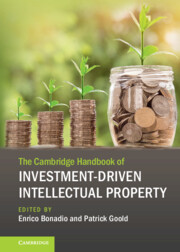Book contents
- The Cambridge Handbook of Investment-Driven Intellectual Property
- The Cambridge Handbook of Investment-Driven Intellectual Property
- Copyright page
- Contents
- Figures and Tables
- Contributors
- Foreword
- Introduction
- I Creativity, Pluralism, and Fictitious Narratives
- Part I Science, Technology and Industry
- Part II Culture and Entertainment
- IX The Press Publishers’ Right under EU Law
- X Copyright in Published Editions
- XI Protecting Sound Recordings
- XII Copyright in Broadcast Transmissions and the Investment-Protection Rationale
- XIII Copyright Protection of Previously Unpublished Works
- XIV Cinematographic Works and Copyright in Nollywood
- Part III Signs, Images and Designs
XI - Protecting Sound Recordings
Between Investments and Creativity
from Part II - Culture and Entertainment
Published online by Cambridge University Press: 16 March 2023
- The Cambridge Handbook of Investment-Driven Intellectual Property
- The Cambridge Handbook of Investment-Driven Intellectual Property
- Copyright page
- Contents
- Figures and Tables
- Contributors
- Foreword
- Introduction
- I Creativity, Pluralism, and Fictitious Narratives
- Part I Science, Technology and Industry
- Part II Culture and Entertainment
- IX The Press Publishers’ Right under EU Law
- X Copyright in Published Editions
- XI Protecting Sound Recordings
- XII Copyright in Broadcast Transmissions and the Investment-Protection Rationale
- XIII Copyright Protection of Previously Unpublished Works
- XIV Cinematographic Works and Copyright in Nollywood
- Part III Signs, Images and Designs
Summary
This chapter focuses on the legal protection of sound recordings. Recorded music is the kind of music people usually listen to in various ways, for example, while enjoying a vinyl spinning at 33 or 45 rpm or songs broadcast by radio or selected via dedicated smartphone applications. Recorded music must be distinguished from music played live. Generally (and technically) speaking, sound recordings are registrations or fixations of sounds embodied in a tangible medium. The latter can be a vinyl record, a cassette tape or an MP3.1 The sounds embodied in these forms of consumption media are traditionally captured and created in recording studios but the introduction of sampling and the digital audio workstation (DAW) has encouraged a music production process where digitised sounds, often originating from diverse geographical regions and time frames, can be harnessed and arranged in a process of music programming, and this affords the production of music in domestic settings without the costly infrastructure of a recording studio or the need to acquire specialised skill sets.
- Type
- Chapter
- Information
- Publisher: Cambridge University PressPrint publication year: 2023



